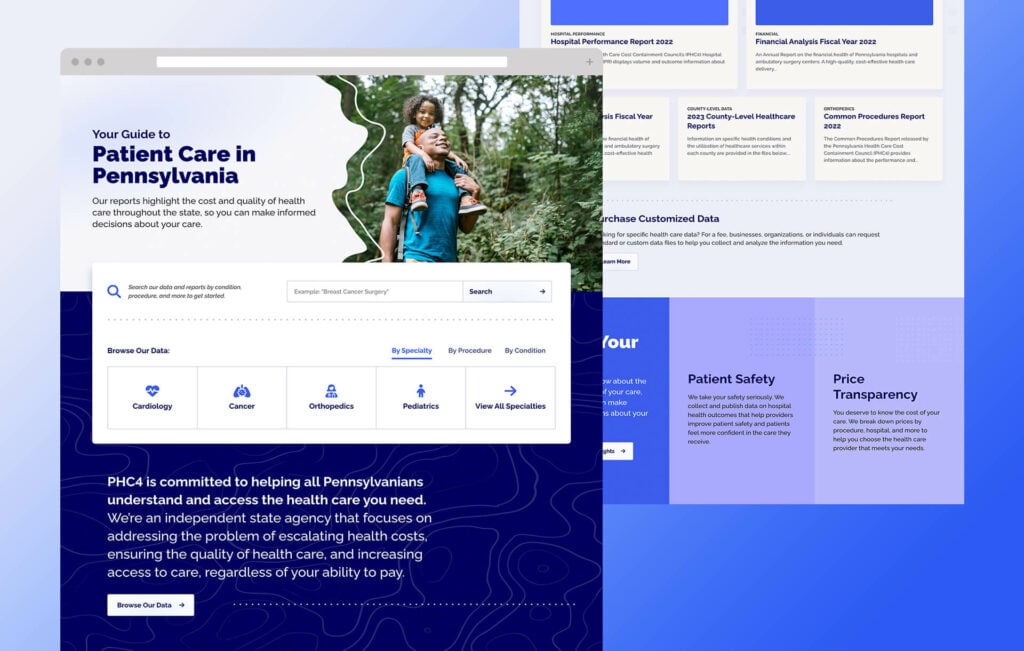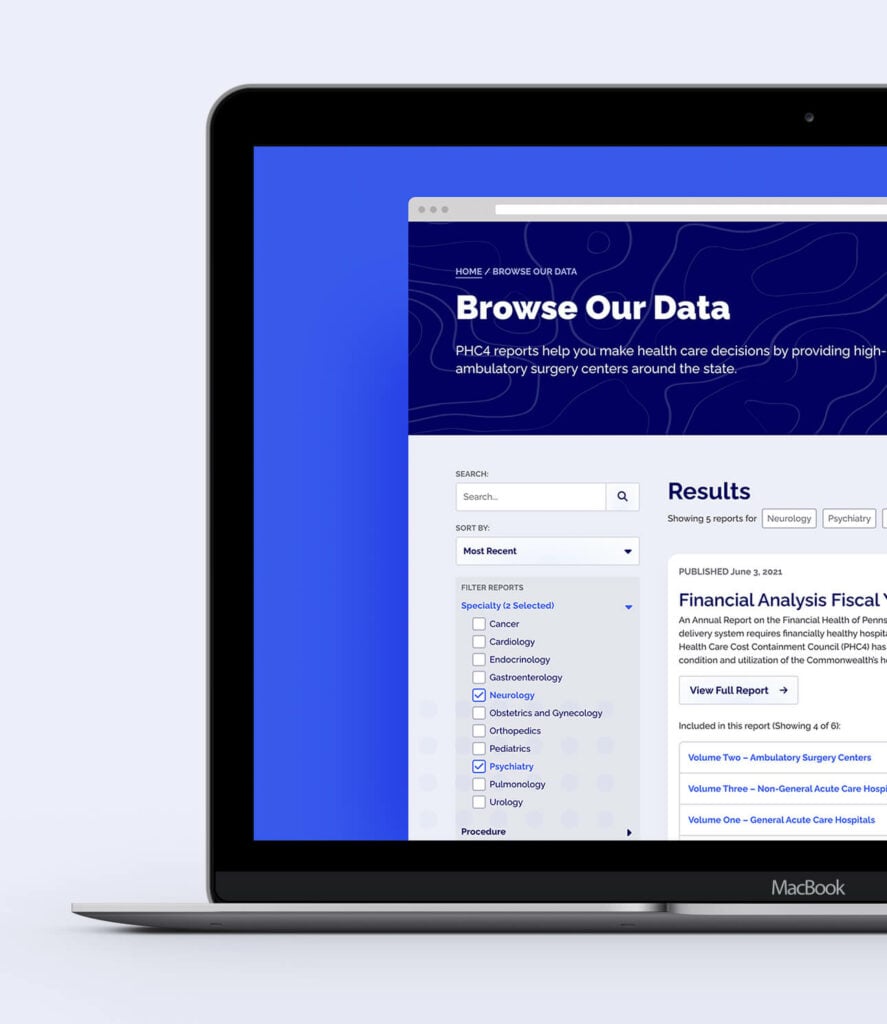eCommerce has primed consumers to expect clear prices. Whether you’re shopping for designer shoes or subscription meal kits, you can see costs with just a click.
Healthcare should be the same. After all, pricing transparency benefits everyone. Informed consumers are empowered consumers, and empowered consumers often make better choices.
This has long been the stance of the Pennsylvania Health Care Cost Containment Council (PHC4).
PHC4 has been collecting and reporting on healthcare data in Pennsylvania since 1986.
It was the first state agency to issue a hospital report card. It now releases data ranging from financial reports and geographic studies to physician outcomes.
Studies have shown this approach is effective. Transparency increases competition, which can improve healthcare quality and outcomes.
After PHC4’s public report cards went online, hospitals in more competitive markets used more resources per patient. In doing so, they lowered mortality rates among the severely ill. Competitive markets achieved a 5-10% reduction in mortality at a cost of $2,000 per case.[1]
How PHC4 works
State law requires hospitals and ambulatory surgery centers to provide data to PHC4 each quarter. PHC4 validates the data’s accuracy. It then compiles it into public reports and databases. These reports give Pennsylvania residents some of the most up-to-date healthcare information in the country.
Until recently, most PHC4 stakeholders were healthcare industry professionals. These included providers, insurers, researchers and policymakers.
With the rise of healthcare consumerism, PHC4 wanted to increase the reports’ usage among consumers.
In doing so, PHC4 hoped to help state residents to make more informed choices.
Making healthcare data available to consumers
To do this, PHC4 needed a new website. Consumers expect a sleek user experience that adapts to any device. PHC4’s dated website design was hurting brand perception.
The site lacked a responsive design for mobile and tablet screens. It relied instead on a separate mobile site with limited functionality. It also lacked search engine optimization, reducing the likelihood that consumers would find and use PHC4 data.
PHC4 teamed with healthcare marketing agency JPL to create its new website. But JPL knew a modern design alone would not meet PHC4’s goals. The organization also needed to align its content with consumer needs. It needed to optimize its site for consumer search. Then, it needed to educate users on the value of its data – and how to use it effectively.
Can consumers and healthcare professionals speak the same language?
Not surprisingly, consumers view healthcare differently than healthcare professionals. Policymakers, regulators and payers judge providers on things such as:
- Hospital-acquired infection rates
- Adherence to evidence-based protocols
- The prevalence of “never events”[2]
These measures focus on the technical and clinical aspects of quality. Consumers, meanwhile, view healthcare quality on more subjective terms. They weigh:
- the patient experience
- the friendliness of staff
- the perceived cleanliness
- the time spent in waiting rooms
Other people’s opinions factor into the equation, too. Eighty-three percent of patients will consult online reviews about a referred provider. Of those, 84% say they will change their minds about a provider if their online ratings are below four stars.
Bridging subjective patient experiences with objective data
Reviews can be helpful for capturing patient experiences, but they have limitations. They are subjective and may reflect personal biases. They lack context. Worse, they are often posted anonymously, and can be rife with misinformation. All these factors can erode the quality of consumer decisions.
According to research from The Commonwealth Fund: “There is considerable evidence showing that for many products and services, consumer choice is subject to limitations in cognition, use of mental shortcuts or heuristics, and systematic biases. Such limitations result in choices that often do not reflect the consumer’s best interests.”
Decision-making errors are most likely to occur when:
- choices are complex
- involve high stakes
- include trade-offs over time
- when consumers have limited personal experience
Healthcare choices often involve all four of these circumstances.”[3]
PHC4 could help reduce these decision-making errors. Its team works hard to validate the quality, accuracy and objectivity of its data. They perform data cleaning, scrubbing and risk monitoring. These efforts benefit healthcare consumers.
Unfortunately, few consumers knew it. The details were buried in PHC4’s report methodology. Consumers who read the methodology had to wade through complex healthcare jargon.
Many of PHC4’s web pages ranked at a collegiate level. Improving readability would help more users read and retain the information.
Consumers are hungry for healthcare information
Consumers are already searching for healthcare information in ever greater numbers. In 2022, 81% of consumers reported using the internet to find healthcare information. This is up from 71% in 2019.[4]
Consumers reported using online searches to:
Healthcare costs remain elusive
Even for the savviest searchers, healthcare costs can be hard to find. Pricing models vary by insurance plans, coverage and geographic location. Regulatory requirements and medical jargon add complexity.
The U.S. Hospital Price Transparency rule, effective January 1, 2021, sought to change this. It requires hospitals to provide prices online or face steep penalties. As of 2022, however, only 70% of hospitals complied with the new rule.[5] Worse, a 2021 survey found that only 9% of adults knew that hospitals were required to disclose care costs online.[6]
Increasing access to healthcare costs and outcomes
PHC4 was in a unique position to supplement these healthcare costs. On its website, much of the data lived in PDF reports. PDFs work well for printing, but the format can limit online accessibility. Search engines can’t crawl PDF content as easily as a static web page. Mobile users need to resize each page to make it legible.
To reduce these challenges, PHC4 paired its PDF reports with simple summaries. It also tagged the reports with taxonomy that aligned with consumer mental models.
On the new site, users now can now find PHC4 data by specialty, procedure and condition. More advanced users can combine filters to narrow PHC4’s reports down to a relevant few.

Better website governance yields a better user experience
Maintaining a large taxonomy can be taxing – no pun intended – for web teams.
JPL used artificial intelligence (AI) to reduce PHC4’s workload.
A GPT-powered website plugin now suggests tags based on the report’s contents. PHC4 team members review the tags for accuracy before publication.
JPL also used the tags to create new topical landing pages. These pages address consumer search intent, helping PHC4 reach a broader audience. Once on site, users can choose from a wide array of relevant content. The related reports boost engagement and enhance the site’s search engine optimization.

A comparison of old and new site data reveals marked improvements.
10%
increase in search traffic year over year
70%
more engagement in priority content
:30
seconds increase in average session duration
70%
increase in engaged sessions for PHC4 reports
Organic search traffic rose 10% year over year. The share of mobile and tablet sessions also rose, reflecting the effectiveness of the site’s mobile responsive design.
Most impressively, users spent more time with the content. Average session duration (the time a user spends on the site during a single visit) rose by nearly 30 seconds. Engaged sessions for PHC4 reports rose 70%.
PHC4 is now exploring ways to link its data to insurance costs and coverage. One day, consumers could pair PHC4 data with online price tools. They could then see personalized treatment options, potential outcomes and out-of-pocket costs.
This technology does not yet exist. But healthcare transparency efforts continue to prove effective. And the teamwork between PHC4 and JPL is bringing healthcare transparency to more consumers across the state.
Need to evolve how your healthcare organization engages with consumers? JPL Health specialists can help. Reach out.
View the work: PHC4 Website
Resources:
[1] https://www.phc4.org/case-studies/competition-and-the-impact-of-online-hospital-report-cards/
[3] Siankio, Bambury, Chien. Consumer Choice in U.S. Health Care: Using Insights from the Past to Inform the Way Forward. The Commonwealth Fund. (Nov. 30, 2021). 4-10
[4] Professional Research Consultants. 2022 National Healthcare Consumer Study
[5] https://www.aha.org/fact-sheets/2023-02-24-fact-sheet-hospital-price-transparency





